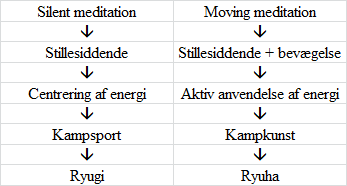
By Tommy Hansen, Member until 2021
Saturday morning in Tårnby, no problems getting up. There is not the shadow of the usual morning stress. Sneak around the house "like a ninja" 🙂 so as not to wake anyone. Both children had friends sleeping and it was a matter of time before the noise would spread throughout the house. A bath, breakfast – no coffee – but a cup of tea with mint and licorice root called Be Cool. Why all the deviation from the daily routines? Because – I was going to Ki & Meditation 1 with Martin Renshi. I had foreseen that the usual coffee poisoning would probably not be beneficial for the course - at least not the essential part of the course. So off I went with the expectation that I would get answers to a lot of questions.
Well - we have previously in Jokokan Amager - with Søren Renshi as instructor - sniffed a little about meditation and breathing exercises - and there you have been cleared of the worst beginner's mistakes - such as that you should not sit in the seiza position unless you are really good at it that, avoid hyperventilating, etc.
I arrived at the course in good time - a little doubtful about my attire. As always, I had brought my gi but had remembered warm clothes and socks - and what luck. Not a bad word about Tjørnelyskolen - but more a statement that there is no heat on the weekend. But then you also stay healthy 🙂 . Back to the outfit – I ended up keeping the pants from the gi on (loose) and then threw on a sweatshirt. It was now ok - but the next time I take part in the course there is no doubt about the dress code.
Despite the lack of focus on clothing, I was ready for class. It cannot be recommended often enough – prepare yourself with previous articles from The Wheel and the Deep Plate or ask your local dojo about experiences. Then you are not behind on points from the start.
Martin Renshi started with a lot of basic terms and different views on meditation, including the difference between meditation in the East, where you meditate to "empty the mind" and in the West you meditate to "fill the mind".
We were also introduced to concepts such as "Silent meditation" and "Moving Meditation" and how it relates to martial arts/martial arts - see the illustration below. A few more pieces fell into place in the great Shindenkan puzzle.
A lot of natural science was also brought into the course, including the function of the brain in connection with meditation, including the beneficial effect meditation can have on the brain, release of stress hormones.
That led on to the concept of Ki (energy) – where we also got into natural science – including how fundamental it is to our existence and how old Ki really is. The connection to the Big Bang. Martin Renshi introduced us to different forms of energy such as light, heat, sound waves, rays, frequencies, aura - and yes, all energies that either work within the body or affect the body. It is essential to understand these connections - so that you can learn to utilize the energies both in everyday life but also against a potential opponent.
After all that talk about energy, we were presented with some colored slides (yellow, red, green, blue) with a big white dot in the middle which got smaller and smaller until the white dot was gone and it changed to almost color. We had to focus on the dot. Simultaneously with the presentation of these moving slides, there was soft sitar music (a la Ravi Shankar) in the background. The colors have meaning for different parts of the body, and you should be able to feel a focus on the relevant part of the body while the color was visible - but I didn't really catch that - it was relaxing and calming - but a little too much hocus pocus for me. I am willing to try it again at a later date - because I think there is something about the "talk". In this connection, I would like to refer to Claus Shishú's article from 6 October 2010 about an earlier edition of the same course.
In relation to the first part of the course around "Silent meditation" and "Moving Meditation", we put some additional definitions in place. Who is not familiar with the term Yin & Yang – but who can actually explain the term? Is the connection between it the good and the evil? Straight to the right according to the Western understanding of the world - but it's not that simple. Yin & Yang – or In & Yo as it is called in Japanese – is directly related to two of our basic katas Ten-i and Chi-i – and now it's about opposites – but also being able to combine these opposites. In any case, I have put a lot of myths and expressions in place so that they make sense.
In the end, we tried 3 different meditations of 10-12 minutes duration, if Martin Renshi's clock on the mobile phone is to be believed - and I can only trust it.
The first meditation was about us having to concentrate on breathing deeply into the lungs, breathing with the stomach, and exhaling and emptying the lungs and with a hand on the stomach focus on the movement of the stomach.
The next meditation was reminiscent of the first but now instead we had to make sure to put the right hand on top of the left and let the thumbs meet - just like our initial etiquette for training in the dojo - mokuso.
In the end, Martin Renshi, with a calm, gentle voice, safely led us through a guided meditation - where the focus was to follow a heat development spread in the body - starting at the big toes.
Common to all three meditations was that the sense of time disappeared completely. It was not clear whether an hour had passed or only 30 seconds. For all three meditations, we had to evaluate afterwards on how it felt, whether we could feel a difference.
In my youth back in the late 80s I used guided meditation, played on my cassette tape player, which was actually designed for bowling, but with the right attitude I learned to use it to prepare for games when I played basketball. It has been many years since I last used the tape - but participation in the course meant that I rediscovered my interest in meditation - and now I feel ready to rediscover, explore and work with ki and meditation (myself) again and this time I am sure that I will reach higher insight than in my teenage years when meditation often ended with a good deep sleep. 🙂
I highly recommend taking part in the course - you can also use it outside Shindenkan and karate auspices. As recently as yesterday I was working from home. My daughter was ill and had been complicit in a restless night. I started my work at 8 o'clock but I was out of sorts to say the least - and I was close to letting myself fall into a deep pit of self-pity. I ended up taking the "bull by the horns" and said NO! - Sat down on a chair, set the stopwatch for 15 minutes and started meditating - despite soft noise from the TV that my daughter was "meditating" on. Against all odds, I managed to complete the meditation. I was not fully rested afterwards, but I felt significantly better than before the meditation and still had a good day's work and had the energy to look after my daughter.
Don't let yourself be limited but meet Ki and Meditation with an open mind - there is more science to it than you would think.




